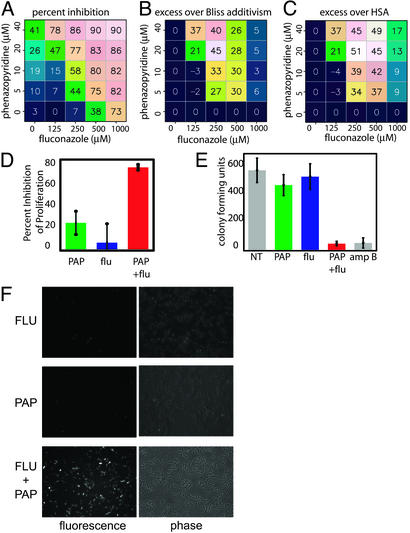Fig. 2.
The combination of fluconazole and phenazopyridine selectively inhibits proliferation of fluconazole-resistant C. albicans.(A) The percent inhibition of fluconazole-resistant C. albicans proliferation is shown for the indicated concentrations of fluconazole and phenazopyridine, determined by using an Alamar blue proliferation assay. The average of three measurements is shown. (B) The calculated excess inhibition over the Bliss additivism model. The predicted Bliss additive effect (see text) was subtracted from the experimentally observed inhibition at each pair of concentrations. (C) The calculated excess inhibition over the HSA. (D) Percent inhibition of fluconazole-resistant C. albicans proliferation at concentrations showing optimal synergy [250 μM fluconazole (flu) and/or 20 μM phenazolepyridine (PAP)]. (E) Fungicidal activity, determined by using a cfu assay. Fluconazole-resistant C. albicans were treated with 20 μM PAP and/or 250 μM flu, or 4 μM amphotericin B (amp B) as a fungicidal positive control, and in each case an equal number of yeast particles were plated in the absence of any compound. The number of colonies that grew after each treatment regime is indicated. (F) The combination of PAP and flu prevents dye efflux. Fluconazoleresistant C. albicans cells were treated with 20 μM PAP and/or 250 μM flu and the effect on efflux of rhodamine G was determined by using fluorescence microscopy. Phase-contrast images of the yeast cells are shown in each case to confirm that a large number of cells were present in each case, but that dye efflux was only effectively inhibited when both PAP and flu were present. For all numerical figures shown, the average of three measurements is represented. Error bars, 1 SD.

